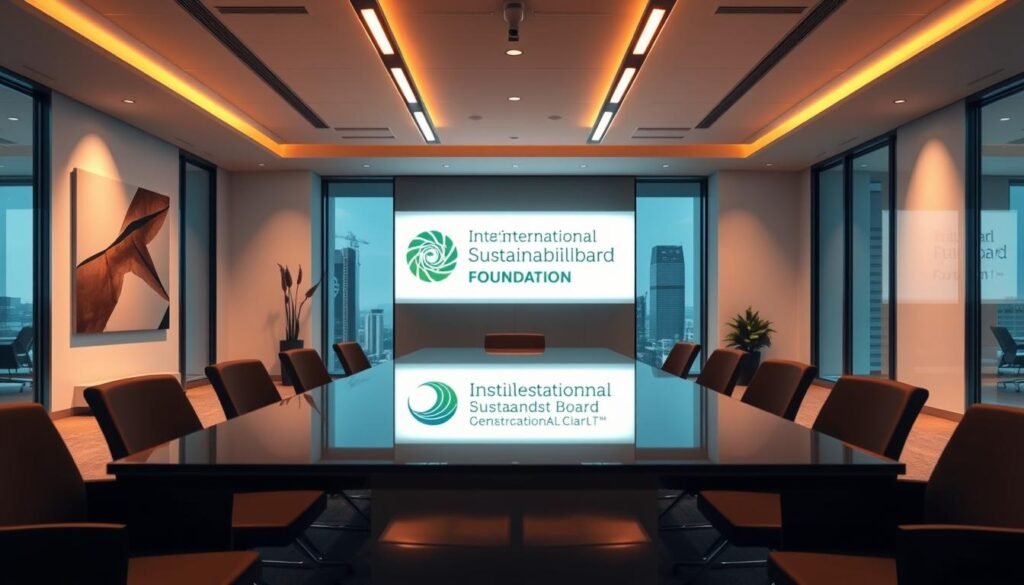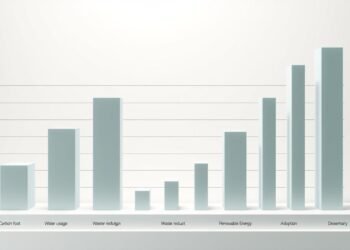What if your company’s financial reports only told half the story? In today’s rapidly changing world, investors and stakeholders demand a complete picture of business performance that includes environmental and social impacts.
In June 2023, the International Sustainability Standards Board introduced groundbreaking global disclosure standards. These new requirements represent a significant shift in how companies report their sustainability performance.
The standards create a comprehensive global baseline for sustainability disclosures. They provide a common language for communicating risks and opportunities related to environmental and social factors.
Companies must now integrate sustainability information with traditional financial statements. This integration helps investors make more informed decisions about long-term value creation.
Major international organizations including the G7, G20, and Financial Stability Board have endorsed these standards. The framework consolidates previous reporting approaches into a unified system.
Key Takeaways
- Global sustainability reporting standards launched in June 2023 create unified disclosure requirements
- Companies must integrate sustainability information with financial statements starting January 2024
- The standards provide a common language for reporting environmental and social impacts
- International organizations worldwide have endorsed these new reporting requirements
- The framework consolidates multiple previous sustainability reporting approaches
- Investors gain better insight into long-term business risks and opportunities
- Reporting includes climate-related financial disclosures and other material sustainability factors
Introduction to IFRS S1 and S2 Sustainability Standards
Imagine a world where every company speaks the same language about sustainability. That’s the powerful vision behind these new global reporting frameworks. They represent a major step forward in corporate transparency.
What Are IFRS S1 and S2?
These two standards work together to create complete sustainability reporting. The first standard covers general requirements for all sustainability topics. It focuses on material issues that affect business value.
The second standard specifically addresses climate-related matters. It includes detailed reporting on greenhouse gas emissions and climate risks. Both frameworks integrate sustainability data with financial statements.
The ISSB’s Vision for Global Sustainability Reporting
The International Sustainability Standards Board aims to create a universal baseline. This approach reduces confusion from multiple reporting frameworks. Investors get consistent, comparable information across all companies.
The board integrated existing frameworks like CDSB and VRF. This consolidation makes reporting more efficient for organizations. The goal is reliable data that fights greenwashing practices.
Effective Dates and Implementation Timeline
Companies must adopt these standards starting January 2024. Early application is permitted for organizations ready to move faster. Both standards must be applied together for consistency.
A transition relief option exists for the first reporting year. This allows companies to focus initially on climate disclosures. The approach recognizes that implementation takes time and resources.
Global entities including IOSCO and the G20 support these standards. The framework is designed to be proportional to company capabilities. It aims to provide value without creating excessive costs.
The International Sustainability Standards Board (ISSB) Foundation
November 2021 marked a turning point in corporate sustainability reporting history. At the COP26 climate conference, the IFRS Foundation announced the creation of a groundbreaking new body. This move responded to growing global demand for consistent sustainability disclosures.
The International Sustainability Standards Board now operates alongside the International Accounting Standards Board. This strategic placement ensures sustainability reporting receives equal importance to financial accounting. Both boards work under the same foundation to create comprehensive corporate reporting.
ISSB Formation and Global Support
The board’s creation represented a direct response to market needs. Investors demanded better information about sustainability risks and opportunities. Companies sought clarity amid multiple competing reporting frameworks.
Global support emerged quickly from powerful international organizations. The G7 and G20 nations endorsed the new sustainability standards board. IOSCO and the Financial Stability Board also provided their backing.
This widespread recognition signals the framework’s importance for global markets. It creates confidence that companies worldwide will adopt these standards. Investors gain comparable data across jurisdictions and industries.
Integration of Previous Frameworks: CDSB and VRF
The ISSB didn’t start from scratch but built upon existing work. It integrated the Climate Disclosure Standards Board framework completely. This provided a strong foundation for climate-related disclosures.
The Value Reporting Foundation also merged into the new structure. This brought valuable resources including SASB Standards and the Integrated Reporting Framework. Companies benefit from this consolidation of previous approaches.
This integration reduces reporting duplication and complexity. Organizations can now follow one coherent framework instead of multiple standards. The approach saves time and resources while improving data quality.
Alignment with International Organizations
The sustainability standards board designed its framework for global relevance. It aligns with needs identified by major international bodies. The Financial Stability Board specifically endorsed the climate disclosure requirements.
IOSCO’s support indicates strong alignment with capital market regulations. This backing helps ensure smooth adoption across different jurisdictions. Companies operating internationally benefit from this consistency.
The framework focuses on providing decision-useful information to investors. It emphasizes material sustainability factors that affect business value. This approach combat greenwashing by requiring verified, comparable data.
Proportionality remains a key principle in the requirements. The standards recognize that companies have different capabilities and resources. This makes the framework accessible to organizations of various sizes.
Ultimately, the ISSB foundation creates a common language for sustainability reporting. It enables investors to make better capital allocation decisions. Companies gain clearer guidance for disclosing their environmental and social performance.
IFRS S1: General Requirements for Sustainability Disclosure
Companies now face a critical challenge: how to measure and report what truly matters beyond financial numbers. The general requirements standard provides the foundation for comprehensive sustainability disclosure.
This framework establishes clear rules for communicating environmental and social impacts. It creates consistency in how organizations report their non-financial performance.
Core Objectives and Materiality Principle
The primary goal is revealing information that affects business value. Companies must disclose material sustainability-related risks and opportunities.
The materiality principle focuses on decision-useful information for investors. Organizations assess what matters most to their specific circumstances.
This approach ensures proportionality in reporting requirements. Smaller entities face different demands than large multinational corporations.
Industry-Specific Disclosure Requirements
Different sectors face unique sustainability challenges. The framework references established standards for industry-specific guidance.
Companies use this guidance to identify relevant risks and opportunities. This tailored approach ensures meaningful reporting across all business types.
Manufacturing firms might focus on supply chain impacts. Technology companies could emphasize data privacy and energy consumption.
Integration with Financial Statements
Sustainability disclosures must appear in the same reporting package as financial statements. This integration helps investors see the complete picture.
The framework shows connections between sustainability factors and financial performance. It demonstrates how environmental issues affect cash flows and costs.
Companies must report on governance, strategy, and risk management. They also need to provide metrics and targets for measurable progress.
The standards work with any accounting requirements worldwide. This flexibility supports global adoption across different regulatory environments.
IFRS S2: Climate-Related Disclosure Standards
Climate change presents both challenges and opportunities for modern businesses. The second standard provides specific guidance for reporting these climate impacts. It builds upon the general framework to create detailed disclosure requirements.
This framework helps organizations communicate their climate performance effectively. Investors gain clearer insights into environmental risks and opportunities. Companies follow consistent methods for measuring and reporting climate data.
Physical vs. Transition Climate Risks
Businesses face two main types of climate-related challenges. Physical risks come from actual environmental changes. These include extreme weather events and changing climate patterns.
Transition risks emerge from moving toward a low-carbon economy. They involve policy changes, technological shifts, and market transformations. Companies must assess both risk categories for complete disclosure.
Physical risks might include supply chain disruptions from floods. Transition risks could involve new carbon pricing regulations. Organizations need to evaluate how these factors affect their operations.
Greenhouse Gas Emissions Reporting
The standard requires detailed emissions accounting across three categories. Scope 1 covers direct emissions from company operations. This includes manufacturing processes and company vehicles.
Scope 2 accounts for indirect emissions from purchased energy. These come from electricity, heating, and cooling systems. Scope 3 includes all other indirect emissions in the value chain.
Scope 3 emissions often represent the largest portion for many companies. They include upstream and downstream activities like transportation and product use. Financial institutions must also report financed emissions from their investments.
Climate Scenario Analysis and Target Setting
Organizations must analyze their resilience under different climate scenarios. This involves short, medium, and long-term climate projections. Scenario analysis helps identify potential risks and opportunities.
The framework requires setting clear climate targets and transition plans. Companies need measurable goals for reducing their environmental impact. These targets should align with global climate objectives.
Carbon credits may be used as part of emission reduction strategies. However, companies must disclose detailed information about credit usage. The standards emphasize actual emission reductions over offsetting.
Industry-specific metrics provide tailored guidance for different sectors. The framework references established standards for relevant performance indicators. This ensures meaningful reporting across various business types.
The climate disclosure requirements align with existing international recommendations. However, they introduce enhanced reporting elements for greater transparency. Proposed amendments will further refine these standards in the future.
This climate-specific framework integrates seamlessly with the general disclosure requirements. Both standards use the same four pillars: governance, strategy, risk management, and metrics. This creates a cohesive approach to sustainability reporting.
Implementing IFRS S1 and S2: Practical Preparation Steps
The transition to integrated reporting demands careful preparation across multiple business functions. Organizations must develop comprehensive systems to meet these enhanced disclosure obligations effectively.
Successful implementation requires strategic planning and systematic execution. Companies need to build robust processes for gathering and reporting sustainability data alongside financial information.
Conducting Gap Analysis and Materiality Assessment
Begin with a thorough gap analysis comparing current practices against the new requirements. This identifies areas needing improvement and helps prioritize resources effectively.
A materiality assessment determines which sustainability metrics matter most to investors. This process focuses on decision-useful information that affects business value and long-term performance.
The materiality principle ensures companies report what truly impacts their operations. Organizations assess risks and opportunities specific to their industry and circumstances.
Developing Sustainability Roadmaps and Governance
Create detailed implementation roadmaps with clear timelines and responsibilities. These plans should include specific milestones for achieving compliance with the standards.
Establish strong governance structures with board oversight and defined management roles. This ensures accountability throughout the sustainability reporting process.
Robust governance frameworks support consistent and reliable disclosure practices. They help maintain data quality and ensure proper oversight of reporting activities.
Data Collection and Quality Assurance Processes
Implement systematic data collection methods with proper controls for accuracy. Ensure consistency and auditability across all sustainability metrics and targets.
Integrate sustainability data with financial systems using technology platforms. This centralization improves efficiency and supports simultaneous reporting requirements.
Organizational education ensures understanding and buy-in across all levels. From leadership to operational teams, everyone must comprehend their role in the reporting process.
Companies face timing pressure as sustainability reports must publish with financial statements. This demands efficient processes and early preparation to meet year-end deadlines.
Conclusion
Global sustainability standards mark a new era in corporate transparency. They offer a clear path for consistent, comparable reporting worldwide.
These frameworks help investors understand material risks and opportunities. Companies gain strategic advantages through enhanced disclosure and governance.
Early preparation ensures smooth implementation and avoids year-end pressures. Organizations that adopt these practices build stronger investor confidence.
The future promises more topic-specific guidance from the standards board. This foundation supports ongoing improvement in sustainability reporting.
FAQ
What are the International Sustainability Standards Board (ISSB) standards?
The ISSB standards are a set of global rules for sustainability and climate-related disclosures. They help companies report risks and opportunities consistently. This gives investors clearer information for decision-making.
When do companies need to start using these new reporting standards?
The ISSB standards are effective for annual reporting periods beginning on or after January 1, 2024. Many jurisdictions are adopting them, so businesses should prepare now for compliance.
How do IFRS S1 and S2 relate to existing sustainability frameworks?
These standards build on and consolidate earlier frameworks like those from the CDSB and TCFD. They aim to create a unified global baseline for sustainability reporting.
What is the "materiality" principle in sustainability disclosure?
Materiality means companies must disclose sustainability-related information that could influence investors’ decisions. It focuses on issues that affect business value and performance.
What types of climate risks must companies report under IFRS S2?
Companies must report both physical risks (like extreme weather) and transition risks (such as policy changes or market shifts). This helps show how climate impacts their strategy and finances.
Are Scope 3 emissions required under these standards?
Yes, IFRS S2 requires disclosure of Scope 1, 2, and 3 greenhouse gas emissions if they are material. Scope 3 covers indirect emissions from a company’s value chain.
How should companies prepare for implementing these standards?
Businesses should conduct a gap analysis, assess material risks and opportunities, strengthen data collection processes, and establish clear governance for sustainability reporting.







